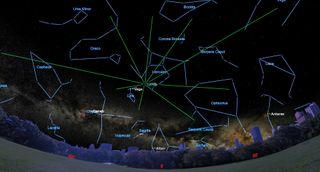If you want to catch a glimpse of a “shooting star,” tonight is your chance.
The Lyrid meteor shower peaks late Saturday night (April 22) into the early hours of Sunday (April 23), giving skywatchers a chance to see some of the fastest and brightest meteors as they streak across the night sky.
According to In the Sky (opens in new tab), the annual Lyrid meteor shower will peak for viewers in New York City on April 22 at approximately 9:00 PM EDT (0100 GMT). The meteor shower will be visible from this area of the US at about 8:29 p.m. EDT (0029) each night, when the point from which its meteors appear to stream, also known as the “radiant,” rises northeast above the horizon. The Lyrids will disappear as dawn breaks at 5:34 a.m. EDT (0924 GMT).
If you can’t make it outside or the viewing conditions in your area are poor, you’re in luck. The Virtual Telescope Project will host a livestream of the Lyrid meteor shower on its website (opens in new tab) and a YouTube channel (opens in new tab) Starts at 8:30pm on April 22 (0030 GMT on April 23).
Related: Meteor Shower 2023: Where, When and How to Watch
The number of Lyrid meteors that are observable increases as one rises above the bright horizon (the point from which the shower originates) in the constellation Lyra near the star Vega. At about 5:00 a.m. EDT (0900 GMT) the radiant is at its highest, and New York is best turned in the direction from which the meteors appear to hang. This increases the number of Lyrid meteors that pass vertically down through Earth’s atmosphere thus creating short trails of light that are never bright.
Long trails from Lyrid meteors can be seen at other times, when fewer meteors burn up in the sky, although these fireballs create long streaks of light. This is because the meteor is entering the Earth’s atmosphere at a shallower angle at this time and thus can cross more of our planet’s sky before burning up.
The Lyreids, which occur around April each year, are not the most active of the meteor showers experienced on Earth each year as our planet makes its annual path around the Sun. NASA points out (opens in new tab)However, while the Lyrids meteors are not as plentiful as August’s Perseids, this celestial April shower is known for fast and bright meteors.
At peak activity and under ideal viewing conditions such as dark skies and clear weather, sky watchers can expect to see about 18 meteors per hour from the Lyrids. Of course, reality is rarely “ideal” so real meteor hunters should expect to see less than this, but still watch out for the occasional bright fireball flash from the Lyrids.
NASA suggests that to increase the chances of seeing the Lyrids, amateur astronomers should move well away from city or street lights equipped with a sleeping bag, blanket, or lawn chair. After observing the dark sky for about 30 minutes to let your eyes adjust to the dark, NASA says you should be able to start seeing meteors with your unaided eye, but patience is required.
Like all meteor showers, Lyrids occur when Earth passes through dusty debris left behind by a comet or asteroid as it orbits the Sun.
As comets approach the Sun, the solid ice converts directly into gas, a process called sublimation, and causes material to be ejected from the comet’s main body. This not only creates the distinctive tails of comets and the characteristic glow around them known as comas, but also leaves debris around the Sun.
When Earth passes through that debris, it enters our planet’s atmosphere at 29 miles (47 kilometers) per second.
The debris that makes up the Lyrids meteor shower is produced by comet C/1861 G1 Thatcher, which takes 415 Earth years to orbit the Sun. The comet was discovered by AE Thatcher on April 5, 1861, and last approached the Sun, or perihelion, that same year.
However, humanity has known about the Lyrids for much longer than they have known about their parent comets. According to NASA, the first recorded sighting of this meteor shower occurred in China in 687 BC. (opens in new tab). This means our ancestors have been marveling at this particular meteor shower for over 2,700 years, making the Lyrids one of the oldest known meteor showers.
If you’re hoping to see the Lyrid meteor shower, our guides to the best telescopes and best binoculars are a great place to start.
And if you’re looking to get photos of the Lyrids, don’t miss our guide on how to photograph meteors and meteor showers, as well as our The best camera for astrophotography And The best lenses for astrophotography.
Editor’s Note: If you take an image of the Lyrid meteor shower and want to share it with Space.com readers, send your photo(s), comments, and your name and location to spacephotos@space.com.
Follow us @Spacedotcom (opens in new tab)or on Facebook (opens in new tab) And Instagram (opens in new tab).
#Catch #shooting #star #tonight #Lyrid #meteor #shower #peaks




